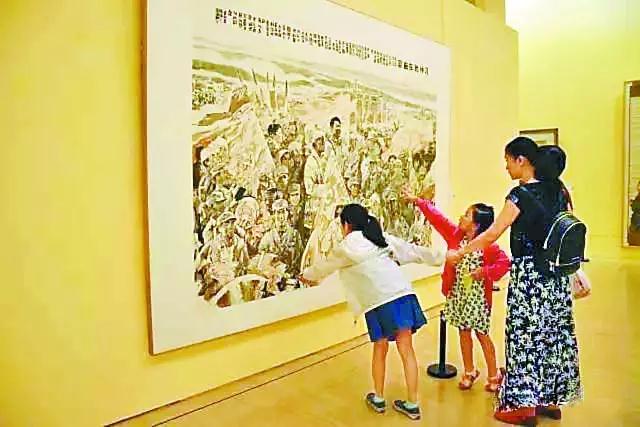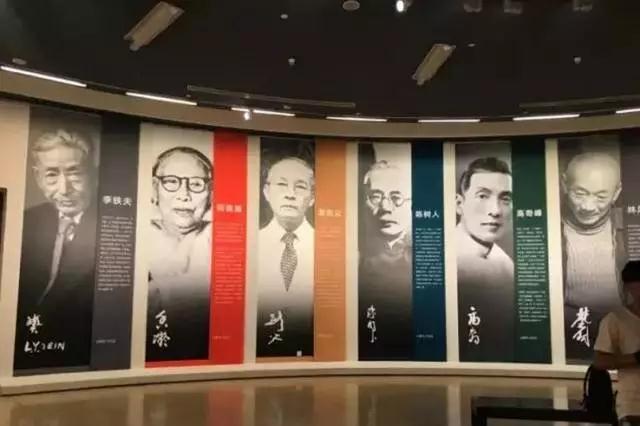Classic Guangdong artwork on display

A CHINESE painting depicting Xi Zhongxun’s bold experiment in governance at a base of the revolution in the early 1930s has attracted attention at the first floor of the National Art Museum of China in Beijing, where 554 works of art created by the top Guangdong artists from the past 100 years are on display from July 8 to July 23.
In the painting, titled “Xi Zhongxun in Nanliang,” Xi, then chairman of the first regional Soviet-style government in Northwest China, is surrounded by joyful soldiers and villagers celebrating the success of his pioneering policies.
Explaining why the painting has been placed in a prominent position in the exhibition, Shen Haixiong, a member of the Standing Committee of the Guangdong Provincial Committee of the CPC who proposed the exhibition, said the Nanliang revolutionary base in Gansu made great contributions to the success of the Chinese revolution, and decades later Xi Zhongxun again acted as a trailblazer by initiating reforms in Guangdong.
The painting serves as a timeline connecting the historical events in Nanliang and Nanyue (southern Guangdong) and reminding us of the spiritual root and source of strength of the reform and opening-up drive, said Shen, who is also head of the Publicity Department of the Guangdong Provincial Committee of the CPC.

The exhibition, titled “Tasked with Reform: The Centennial Exhibition of Guangdong Fine Arts,” also underlines Guangdong’s reformist role in transforming Chinese art over the past century. Li Tiefu, dubbed the “father of Chinese oil painting,” “female revolutionary” He Xiangning, founders of Lingnan School Gao Jianfu, Gao Qifeng and Chen Shuren, print pioneers Huang Xinbo, Gu Yuan and Li Hua and contemporary artists Guan Shanyue, Li Xiongcai and Yang Zhiguang, are all big names from Guangdong who have reshaped the art landscape in China.
Guangdong played historic roles in transforming feudal China into a modern society and a rising power. As one of the most important origins of the ancient Maritime Silk Road, the province has been one of the country’s major gateways of international exchange for the past 2,000 years. The exhibition highlights Guangdong’s roles as pioneer, reformer and innovator in the development of the country’s fine arts.
Guangdong’s art reflects China’s historic rise and best represents the Chinese nation’s self-confidence in aesthetics, said Zheng Yanxiong, executive deputy chief of the Publicity Department of the Guangdong Provincial Committee of the CPC.
“The development of fine arts in Guangdong over the past 100 years epitomizes China’s fine art development. Guangdong artists have conducted bold experiments and created new practices toward the modernization of Chinese fine arts and the assimilation of foreign arts,” said Liu Dawei, chairman of Chinese Artists Association.
“Guangdong’s fine arts were born with the spirit of innovation,” remarked Xu Qinsong, curator of the exhibition and chairman of the Guangdong Association of Artists. “Guangdong artists have embraced the impact of Western culture over the past 100 years and found a path for a modern transformation of Chinese arts. While keeping traditional Chinese arts as the foundation, they assimilated and integrated Western artistic achievements, initiated reforms and innovations, and created a ‘propeller’ for the modern transformation of Chinese arts.”

The exhibition has attracted many residents and art students even with the Chinese capital sweltering in the scorching heat. As the eyes of one elderly visitor fixated on the painting “Lion” by He Xiangning, he said it was unbelievable that the painting of this powerful beast had been created by a female artist. The painting depicts a lion, which seems to have just been startled from sleep, piercing the soil with his paws in the tense moment before rising to leap at his imagined antagonist. He Xiangning was one of the earliest members of Sun Yat-sen’s revolutionary movement, who started out studying the Japanese painting style before becoming a famed artist of the Lingnan School, with many works infused with masculine heroism.
Many visitors were also deeply touched by “Flames in the Eastern Battlefield,” one of the most famous works by Gao Jianfu, a co-founder of the Lingnan School. The painting — which recreates the scene of the aftermath of a bombing by Japanese invaders in Shanghai in the 1930s — marked an unprecedented break from the tradition of scholarly paintings, and played a very significant role in the “artistic revolution.”
The innovation and creativity of Guangdong artists is also evident in other paintings, wood carvings, prints and sculptures on display.
Before the opening of the exhibition, the academic board of the exhibition selected 21 masters from the 100-year history of Guangdong fine arts, including Li Tiefu, He Xiangning, Gao Jianfu, Gao Qifeng, Lin Fengmian and Guan Liang.
The exhibited works and 1,020 pieces featured in the book “Tasked with Reform: Works in the Centennial Exhibition of Guangdong Fine Arts,” were selected by the academic board through multiple rounds of open and fair voting.
The exhibition also demonstrates technological innovation. Visitors can scan the QR code printed on the label of each work to view an animation, and a virtual exhibition hall is available on an app, allowing people in other cities to appreciate the masterpieces. Virtual reality scanning is also being used to make the exhibition more interesting.